Voice analysis guide
This is the ultimate guide to analyze your singing voice.
Here we break down singing technique assessment into a step by step process.
We suggest using it as a checklist while listening to your own recordings or getting feedback from a vocal coach.
🖇️ Quick links
- Pitch Accuracy Test - sing through the major scale and see how many notes you can hit
- Vocal Range Test - find your lowest and highest notes
- Vocal Pitch Monitor - instantly shows which notes you sing
- Spectrogram - record your voice and visualise a spectrogram
- Singing Voice Analyser - upload mp3 file with a vocal recording to analyse pitch and timber
- Statistics - Track how your voice changes over time
🧱 Singing technique breakdown
- Intonation
- Breath management
- Diction
- Constrictions
- Vocal registers
- Nasality
- Twang
- Onsets & offsets
- Posture
- Jaw
- Tongue tension
- Lips
Intonation (hide)
Intonation is pitch accuracy. You might be familiar with people saying that something sounds “false” or “out of tune”. Basically what they mean is that the sound that is created isn’t “precise” but just around the pitch that is supposed to be sung. Intonation might be flat (right below the pitch we were aiming to sing) or sharp (right above the pitch we were aiming to sing).
We offer these tools to help you track your intonation:
- Pitch Accuracy Test - sing through the major scale and see how many notes you can hit
- Voice Analyser - record an audio with your voice and see which notes you hit on a chart
Breath management (hide)
Breath management simply means your ability to adjust your breath to the tone quality (falsetto, chest voice, mix, etc) you’re producing or the length of the phrase you’re singing.
For example, if you’re singing short phrases, there will not be a need for big breaths in - that would only block you and restrict you. The same way when you’re singing a long phrase, you’ll need to prepare and have an estimation of how much breath you should take in at the beginning and how you should divide it along the way (not using it all at once at the beginning of the phrase).
Remember:
- When breathing in, relax your abdomen (belly) to let the breath come in and keep your shoulders relaxed and low.
- When breathing out, let your body do the work first before you engage your abdominal muscles. That means, do not immediately squeeze your belly muscles - that will create unnecessary strain and tension and you will end up pushing the sound.
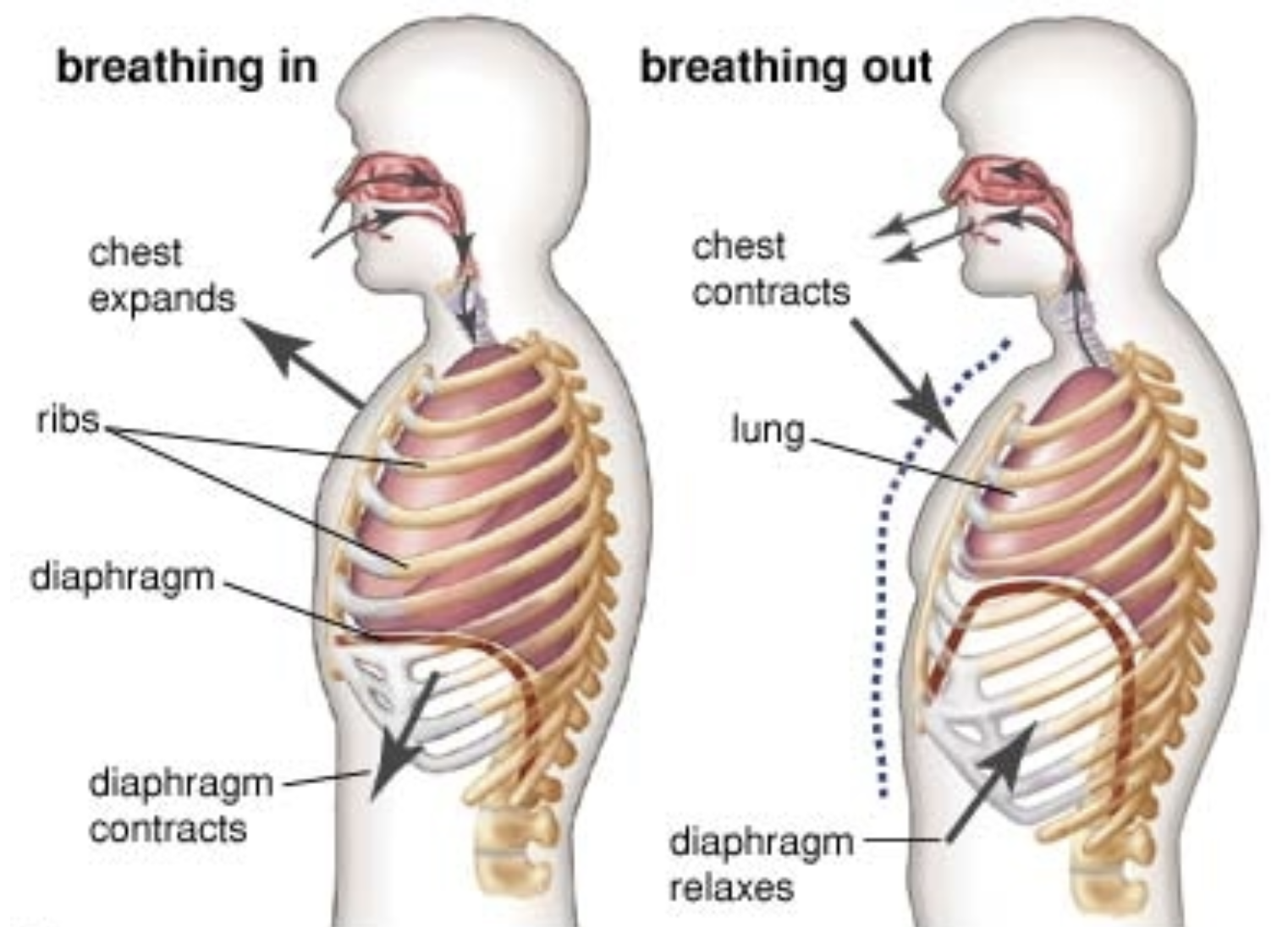
Diction
Make sure anyone can understand the lyrics without a problem =)
Constrictions (hide)
Constriction (strain in the voice) is the feeling of closing of your throat that you might get when you sing. It might occur at any moment during singing, depending on what happens in your body. Very often constriction happens when we sing higher notes but there are many reasons and moments for it to occur.
Technically what happens is that our false vocal folds (membranes on both sides of our throat) that sit right above our true vocal folds start closing due to excessive tension, usually created in our belly but also in our jaw or tongue.
It’s a natural and protective reaction of your body that occurs when something falls into the “wrong hole”. Our body “closes” the throat to protect our lungs from any particles (water, food) falling in. It occurs also when we need to perform a heavy, physical task like picking up a heavy object.
Try it and notice the space changing in your throat.
Vocal register (hide)
A vocal register is a range of tones in the human voice produced by a particular vibratory pattern of the vocal folds. These registers include chest voice (thick vocal folds), vocal fry, falsetto, and the whistle register. You might also hear about “mix voice” which is a mix between thick and thin vocal folds. Check this video to understand what it means:
Nasality (hide)
Nasality is a term that describes sounds that sounds nasal - as if coming through your nose. And that is literally what happens when we hear a sound that’s nasal.
During singing our sound travels through our throat to our mouth and out. On its way, it can take other ways if possible. One of the ways is the nasal passage which has its opening at the end of our mouth. That’s also where the little flap that closes the opening is. We call it velum (soft palate). You can feel it by moving your tongue past your hard palate (roof of your mouth) all the way to the back until you feel the soft part.
During singing the flap can be open or closed. When the flat is closed (up), our sound has no other way out except throughout our mouth and the sound becomes oral. If the flap is open (down), the sound has an extra exit route and it gets divided between our mouth and nose and we hear the sound being nasal. How nasal depends on how low our velum (soft palate) is.
Tip: When singing, pinch your nose with your fingers closing it and then opening it again. Listen to the sound. If you hear a change between opening and closing, that means your sound is nasal. If no change occurs, your sound is not nasal.
Twang (hide)
Twang is a common name for a certain change occurring inside our voice box (larynx). That change is the movement of the epiglottis. What is epiglottis? It’s a flap of tissue that sits beneath the tongue at the back of the throat. Its main function is to close over the windpipe (trachea) while you're eating to prevent food entering your airway.
When using twang we will not close the throat fully but only partially, making the throat narrower. Due to that narrowing our voice “shoots” out through our throat, into the mouth and out. The sound that is created is bright and loud without effort increase. We can adjust the brightness and loudness with the degree of the narrowing in the epiglottis. It is an essential feature of opera and belt singing (very big and loud sound used in a musical theater but also others like: pop and rock).
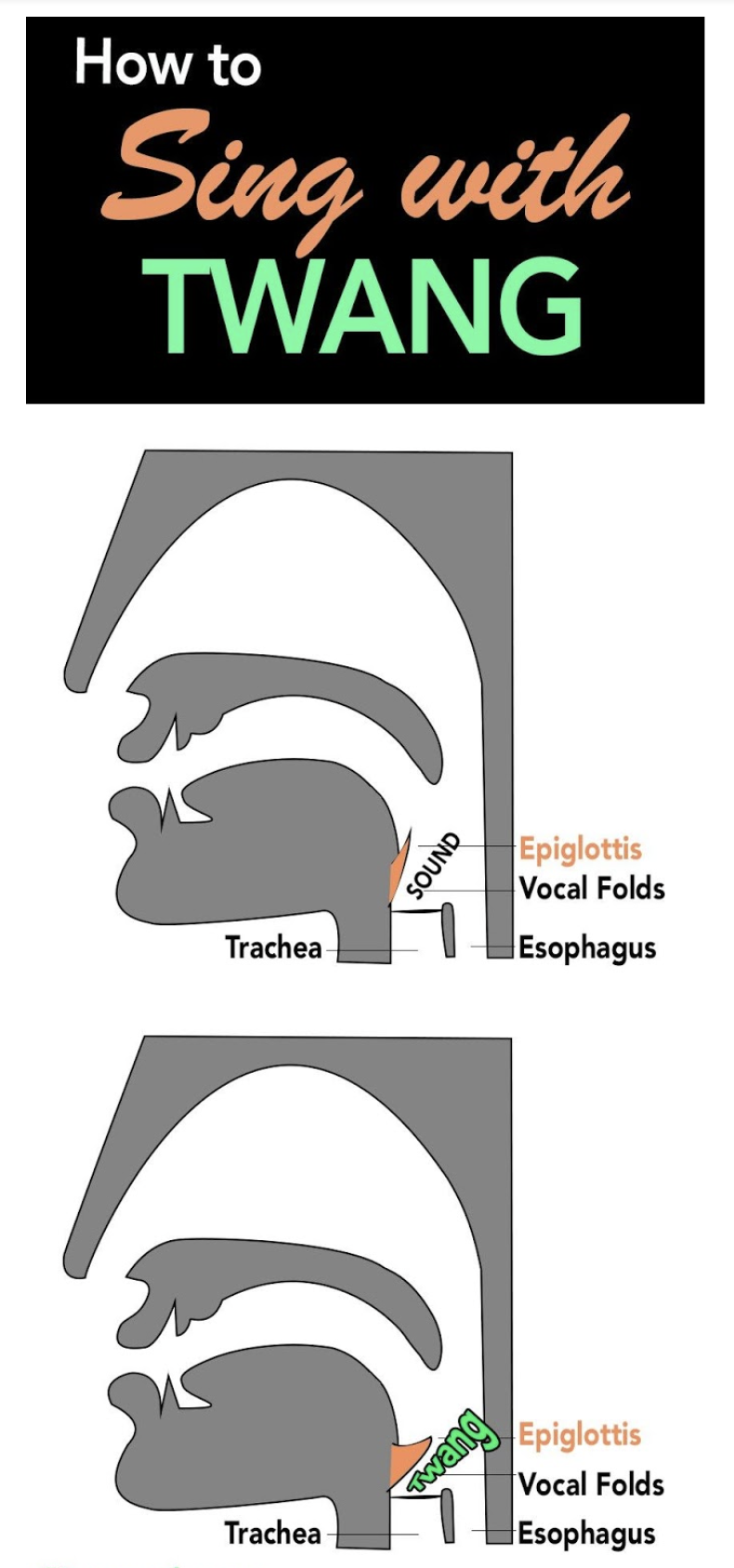
Onsets & offsets (hide)
Onset means literally the way you begin the sound. In singing, we distinguish 4 different types of onsets:
- Glottal: the air and sound begin at the same time. It has very distinguished, sometimes sharp click/ blop at the beginning as when saying “are” or “is”
- Asprit abrupt: We begin with air and then we hear a little pop sound when the voicing begins as in “how”
- Asprit gradual: We hear the air and then the sound slowly blends in, so the popping sound doesn’t happen anymore, as in “hey”
- Simultaneous/ smooth: The air and the sound start at the same time, so we do not hear any sharp beginning or that popping sound like in the previous onsets.
Offset is the way we end sounds. The same rules and principles apply as in onset.
Posture (hide)
Your body is your instrument so it’s important that the way you stand or sit while singing supports your voice. Make sure your abdominal (belly) muscles are relaxed, pelvis tilted forward, your chest open and head looking forward so not tilted down or upward. It helps to feel the space between your arms and body almost as if there’s an imaginary ball of air under your armpits ;)
When sitting, remember to not slouch! Sit on the edge of the chair with your feet touching the ground (if possible!) and your back straight, allowing your rib cage to expand with every breath.
Standing:
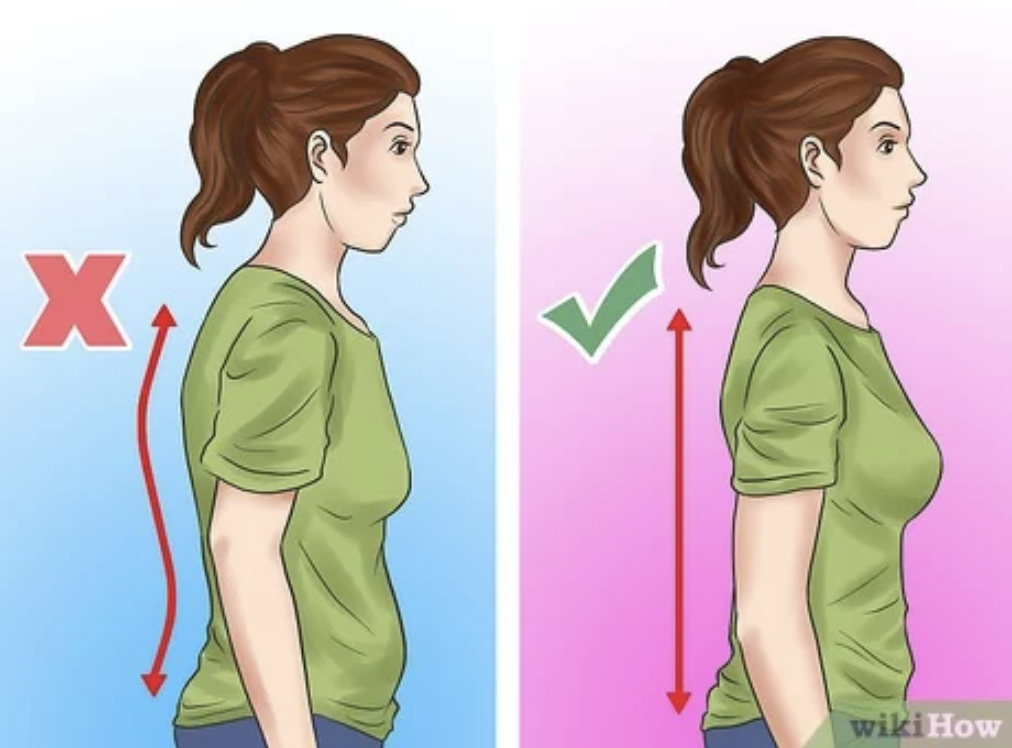
Sitting:
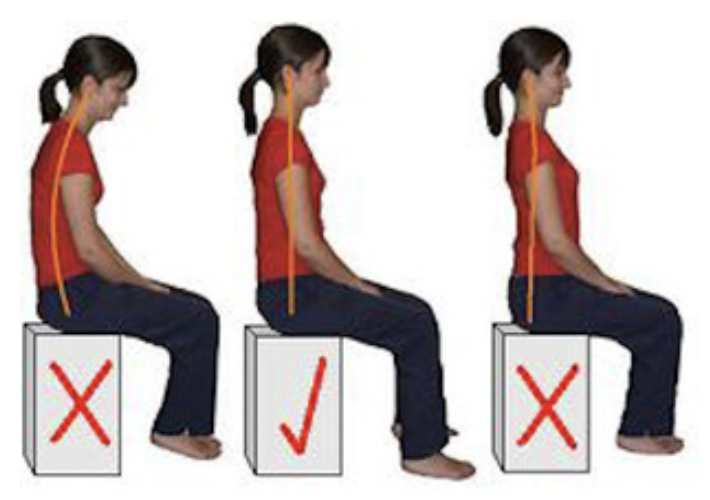
Jaw (hide)
Your jaw is able to move due to the temporo-mandibular joint (TMJ). The jaw muscles that allow it to move can get very tense for multiple reasons of which stress is the most common one. These muscles are very strong and so the tension can get very strong as well without us even noticing it.
In singing, the most important is that your jaw stays relaxed at all times. When tensed, the sound you’re trying to produce might be impaired. If you think that your jaw is tensed, you can follow a few simple jaw exercises to release it. To get an idea of whether you’re tensing your jaw while singing, insert your pinky between your teeth and sing as you normally would. Notice if you can keep it relaxed or if you’re biting on your finger while doing it.
Tongue tension (hide)
The tongue is considered one of the strongest muscles in our body and thus gaining control over it can be sometimes tricky. The root of the tongue is also the front of the throat that’s why keeping it relaxed at the root is so important. We do not want it to unintentionally change things in our larynx when singing.
Its main job in singing is articulation however sometimes due to habits or native language it causes trouble when singing. When the roof of the tongue is tensed it will pull back and block our larynx or push them downwards causing a voice strain. It can also affect your tone and resonance by constricting your throat space.
Various tongue positions when pronouncing different vowels:
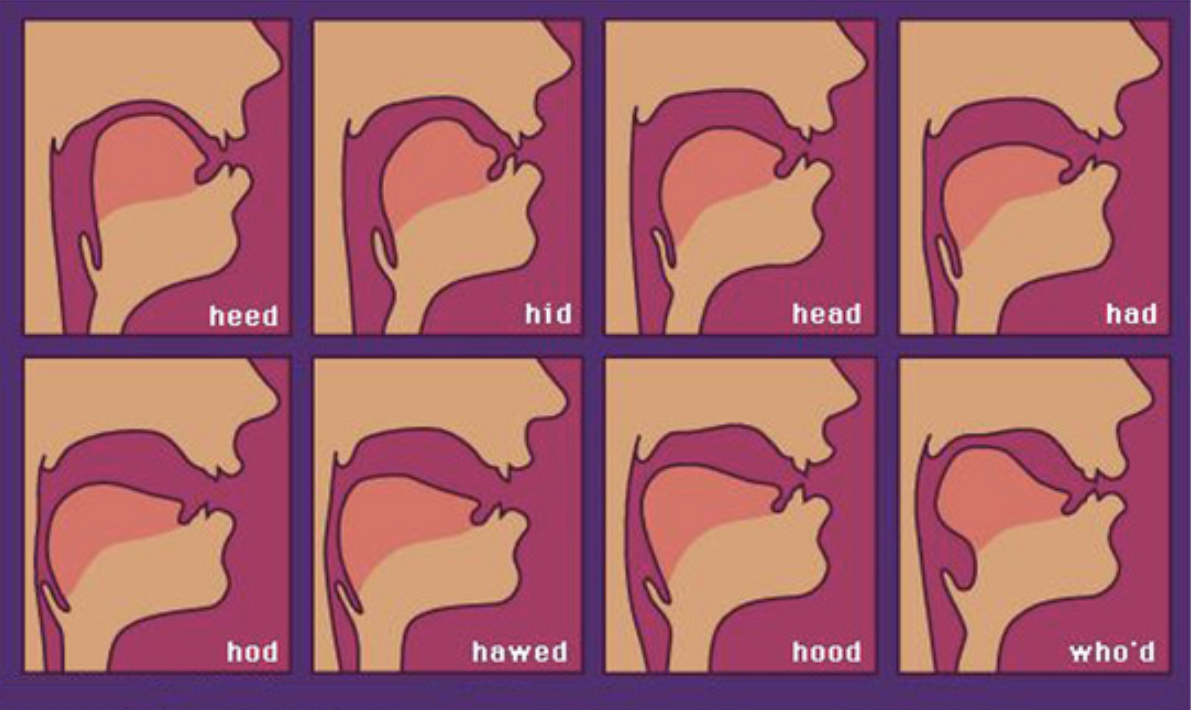
Lips (hide)
Lips play a big part in achieving colours in our singing. With protruded/ rounded lips, the sound will become darker and with wide spread lips (like in a smile) our tone will get brighter. There is no wrong or right when it comes to lips shape when singing. Always make sure that the tone you’re making fits the style of the song and that you yourself like it. Be aware of the possibilities that the shape of your lips gives you.
Listen to the explanation and examples here:
